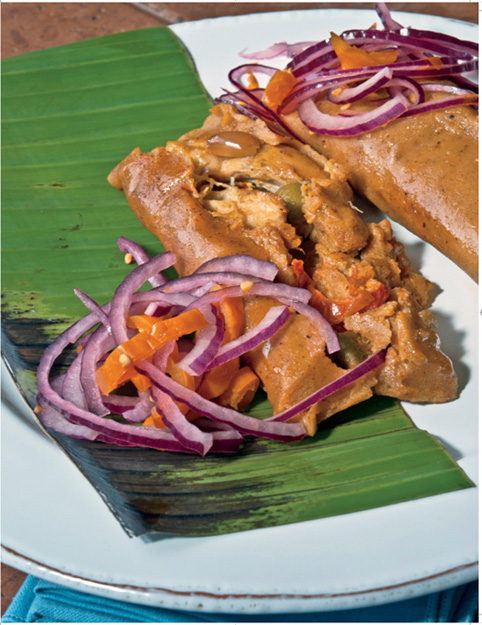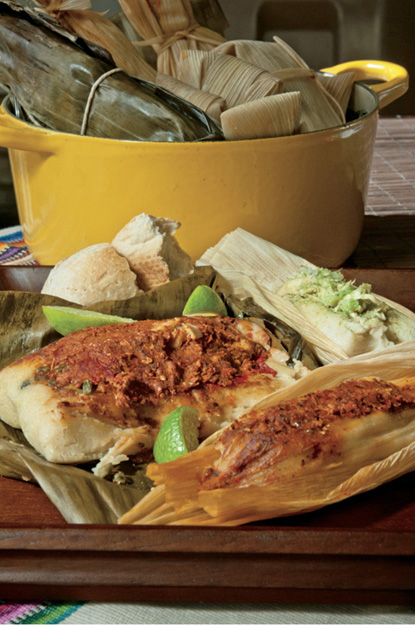I like to say that Latin America’s backbone is made of corn and cassava and at its heart is a deep respect for the soil that gave the world chocolate, chiles, potatoes, squash, nuts, tomatoes, and so many other precious ingredients. If you really want to taste the spirit of the Americas, you must first discover the vast world of tamales. All of the ingredients native to the New World play a key role in crafting these dumplings, which date back to the pre-Columbian era. Many people think that all Latin Americans eat tortillas, but it’s really tamales that truly connect us, from Mexico all the way to Patagonia. So jump on the tamale train and bring your appetite for an adventure filled with facts, fun, and flavor.
When the Spanish conquerors arrived in the New World, they found that the indigenous peoples had already developed hundreds of varieties of corn, known in Mesoamerica as maíz and in South America as choclo. Bernal Diaz del Castillo, who was among those traveling with Hernán Cortés, described tamales as uncooked corn dough, plastered on husks, spread with fillings and then folded like envelopes. In essence, the same description still applies to the myriad tamales prepared today all over Latin America—except that not all of them are made with corn; some are made with plantains or root vegetables like cassava, malanga, potato, or ñame; and others are made with rice.
The word “tamal” comes from the Nahuatl word tamalli, but each country has its own name for tamales and its own special way of making them. Among the myriad tamales you’ll find, are pamonhas in Brazil, humitas in Bolivia, pasteles in Puerto Rico, and chuchitos in Guatemala. In Nicaragua, if they include meat, they’re called nacatamales, and in Mexico, tamales shaped into cones and filled with cheese and vegetables are called corundas. Even when tamales have the same components, such as those made with fresh corn and cheese, they’ll go by different names, depending on where you find them.
Tamales are always available on the streets, sold from baskets, coolers, or giant steaming pots over wood fires. People buy them mostly because they’re tasty and satisfying but also because they’re portable. I chose a variety of recipes here for tamales, from those served every day to the ones usually reserved for celebrations. You’ll notice that most of these recipes will yield at least a dozen tamales. The good thing is that all of them freeze beautifully and are easy to reheat. My recipes will tell you how.
Since tamales can take a long time to assemble, it has long been a tradition in many Latin homes to hold tamaladas, or tamale-making parties, in which cooks gather to prepare them. It’s a fun way to spend an afternoon, and it helps to expedite the process. Carve out a few hours in your day to make tamales, or do what Latin Americans do and invite a few friends to help you make a party out of it!
Tamales come in all sorts of shapes: round, rectangular, square, conical, and triangular. They’re also wrapped in different kinds of leaves. The recipes I’ve included here call for corn husks (both dried and fresh) and banana leaves because they’re the easiest wrappers to find. If you can’t find either, don’t worry. You can wrap tamales in parchment paper and then aluminum foil to seal them; they won’t taste the same but they’ll still be delicious.
Every Christmas Eve, my family gathers around the table to eat traditional tamales. The aroma of banana leaves, chiles, and pork reminds us of past holidays in Guatemala, where carpets made of fresh pine needles dressed the tiled floors and wreaths made out of stringed white cherry fruit called nances hung from the ceiling. Wherever there are tamales, there is a fiesta. I hope you’ll experience the joy of opening each one of these little edible gifts and traveling through centuries of flavor.
PREPARING CORN HUSKS AND BANANA LEAVES FOR TAMALES
Before you get started on any recipe for tamales, you’ll need to prepare the corn husks or banana leaves.
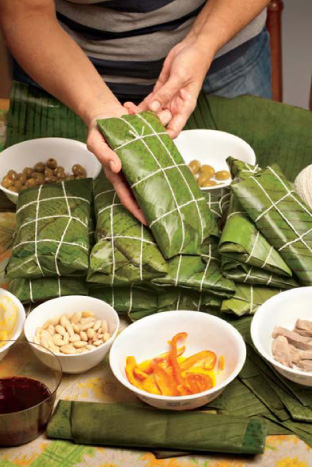
Venezuelan tamales, or hallacas, and ingredients for the filling.
Corn Husks
To prepare dried corn husks, soak them in warm water for at least an hour, then separate the husks. Remove any silk and discard. Keep the husks submerged in water as you work so that they don’t dry out (use a heavy plate to keep them under water). Tear 1/8-inch strips following the natural ridges of the husks to use for ties (make them thicker, if the husks are too brittle). Use the largest husks for wrapping the tamales and use the small ones to line the pot you’ll steam them in. Store any leftover dry husks in plastic bags in a dark place for up to two years. Any leftover soaked husks can be dried again. Shake the excess water off and spread them out on towels on your kitchen counter to dry for several days. Don’t dry them in the oven because they could catch on fire. Once dried, they can be stored as indicated above.
The size of the corn husks will dictate how long the strips you make for tying the tamales will be. The ideal corn husks are at least 8 inches wide and 10 inches long. If the corn husks are on the smaller side, you may have to use kitchen twine to tie the tamales. If the corn husks are too small and you’re having trouble shaping the tamales, just slightly overlap two husks so you can encase the filling. All tamales resemble packages but traditionally, most tamales resemble envelopes, with the edges of the corn husks cleanly meeting in the middle and tied in the center. Some are left open on the top and others are tied on both ends like a candy wrapper.
Banana Leaves
Banana leaves come whole and furled into bundles. If they are frozen, thaw them at room temperature for at least two hours. To prepare them for cooking, unfurl the leaves on a long counter. With scissors, cut away the tough outer vein from the two sides of the leaves and discard. Cut the leaves to the size indicated in the recipe. At this point, they must be flamed over a gas stove or, if you don’t have a gas stove, simmered in boiling water to make them pliable and to remove their sticky, bitter sap. To do this on a gas stove, turn the burner on to medium-high and, working with one leaf at a time, pass it quickly back and forth directly over the flame just until it turns bright green and becomes pliable. To cook the leaves on an electric stove, bring a large pot of water to a boil over medium-high heat and place the leaves in the pot; simmer until they turn an olive green color, about 2 minutes. Remove them from the water and cool completely. Do not eat the banana leaves!
AN IMPORTANT NOTE ABOUT WORKING WITH MASA
Not all masa is created equal. Depending on what you’re making, the consistency of the masa will vary: sometimes it should feel like soft mashed potatoes, sometimes stiff cookie dough, and sometimes smooth playdough. Read the recipes carefully, so you know what the masa should feel like for each dish. Sometimes the masa will have to be precooked, while other times it will simply need to be mixed with water.
Finally, some of the tamales in this book will be steamed and others will be boiled. When steaming tamales, it will be important for you to keep the water at a constant simmer. If you need to replenish the water as it evaporates, use boiling water so the temperature doesn’t drop suddenly and you lose the steam. Likewise, if a recipe calls for boiling the tamales, add only boiling water if you need to replenish it. Be sure to keep the water at a rolling boil to prevent the tamales at the bottom of the pot from burning. Tamales should never be microwaved.
These are the traditional Christmas tamales of Venezuela, where many busy cooks purchase them from street vendors and take them home. The filling is made out of the same precooked cornmeal used to make arepas. The resulting tamales are very different from those made with the nixtamalized corn masa used in Mesoamerica. The masa is topped with a vegetable mixture called guiso; then it’s studded with meats (chicken, pork, or beef), raisins, and olives. Traditional hallacas are intricately wrapped in three different shaped banana leaves, but I use an easier method using a combination of banana leaves and aluminum foil. Like many South American tamales, these are boiled, not steamed, so be sure to wrap these as directed to ensure they don’t get waterlogged. Hallacas can be frozen after they’re cooked and cooled; before serving, they must be boiled or steamed until hot.
Makes 8
3/4 cup melted lard, vegetable shortening, or chicken fat
2 tablespoons annatto (achiote) seeds
1 cup minced leeks (white and light green parts only)
1 cup minced white onions
1 cup minced plum tomatoes
3/4 cup minced red bell pepper
7 cups chicken broth
1 1/2 teaspoons salt, divided
5 cups precooked cornmeal (masarepa or harina pan), divided
2 cups cooked and shredded chicken, chilled
2 bacon slices, each cut into 4 pieces
16 Manzanilla olives
24 large capers, rinsed
24 raisins
1–2 tablespoons slivered almonds
1 pound banana leaves, prepared as directed on pages 242–43 and cut into 9 1/2×12 1/2-inch sheets
8 (12×20-inch) sheets aluminum foil
In a small saucepan, melt the lard over medium heat; add the annatto seeds, reduce the heat to medium-low, and gently simmer the lard for 45 seconds to 1 minute, being careful not to burn the seeds. Remove the pan from the heat and steep the seeds for 10 minutes. Strain the seeds and discard; reserve the lard.
Heat 1/4 cup of the reserved lard in a medium skillet over medium-high heat. Add the leeks, onions, tomatoes, and bell peppers and cook, stirring often, until soft, about 10 minutes. Add 1 cup of broth and continue cooking until most of the broth has evaporated, about 5–6 minutes. Remove from the heat.
In a large bowl, combine 4 cups of the masarepa, the remaining lard, and the remaining broth; stir with a wooden spoon until the mixture is smooth and the texture of soft mashed potatoes. Gradually add the remaining 1 cup of masarepa, kneading it into the dough for 2–3 minutes or until it’s the consistency of playdough. (If it’s too stiff, add a bit more broth; if too wet, add a bit more masarepa). Divide the dough into 8 equal portions (about 1 cup each).
To assemble: Making one hallaca at a time, center a banana leaf on a sheet of the aluminum foil lengthwise, with the long side toward you. Spread a portion of the prepared dough in the center of the banana leaf, shaping it into a 6×4 1/2-inch rectangle. Spread 2 tablespoons of the vegetable mixture and 1/4 cup of the chicken over the dough. Arrange a piece of bacon, two olives, three capers, three raisins, and 1/2 teaspoon almonds on top. Fold the long sides of the banana leaf over the filling and then fold the sides of the leaves in to make a package. Place the hallaca seam-side down on the foil and wrap it tightly in the foil to seal. Repeat with the rest of the ingredients.
Bring a large pot of water to a boil. Drop the hallacas into the pot, cover, and boil for 30 minutes. Drain them in a colander over the sink for 10 minutes. Remove the foil and slide the hallacas from the banana leaves onto a plate; discard the leaves.
NOTE: To freeze hallacas, cool them completely (still wrapped) and freeze in a single layer until solid. Transfer to freezer bins or zip-top bags and freeze for up to 3 months; to reheat, boil (without thawing beforehand) until hot, about 30 minutes.
Guatemalan Christmas Tamales (Tamales Colorados)
In my home, it’s not Christmas until the kitchen is filled with the aroma of these banana leaf–wrapped tamales filled with pork that has been deliciously bathed in a terracotta-colored sauce called recado. Inside each striking package is a white dumpling dressed with the colors of the holiday season. Every year in Guatemala, people line up to purchase tamales from their favorite tamaleras, so they can take them home to eat them on Christmas Eve. Some cooks add potatoes or rice to the filling, but this is the way we make them at home. My husband, our daughters, and I get into the holiday spirit by making these tamales together every year. Many times we’ve enlisted friends to help and after breaking bread together at our table, send them home with some of these edible gifts. The sauce can be made two days before the tamales are assembled. Serve these tamales the way they’re meant to be served: with plenty of lime wedges and crusty French bread. In place of pork, you may use chicken or turkey.
Makes 15 tamales
2 pounds boneless pork butt
5 cups chopped plum tomatoes
12–15 medium tomatillos, husks removed, rinsed and chopped
1 chopped red bell pepper
1/3 cup minced white onion
2 large garlic cloves, peeled and left whole
1 ancho or pasilla chile, seeded and deveined (reserve the seeds)
1 guajillo chile, seeded and deveined (reserve the seeds)
1 (5-inch) stick Mexican cinnamon (canela)
1/2 teaspoon ground cloves
2 tablespoons annatto (achiote) paste
1/2 cup sesame seeds
1/2 cup raw pumpkin seeds (pepitas)
1 tablespoon plus 1 teaspoon salt, divided
8 cups masa harina
Reserved pork cooking broth plus enough water to make 11 cups
2 cups lard (or vegetable shortening)
2 1/2–3 pounds fresh banana leaves, prepared as directed on pages 242–43 and cut into 15 (roughly 12×13-inch) and 15 (roughly 8×9-inch) rectangles; reserve the scraps
15 large capers, rinsed
15 Manzanilla olives
1 (2-ounce) jar sliced pimientos
Kitchen twine cut into 15 (30-inch) pieces
Lime wedges
Place the pork in a large pot, cover with water, and bring it to a boil. Cover, reduce the heat, and simmer until fully cooked, about 50–55 minutes. Cool the pork in the broth. When cool, strain the broth and chill it until ready to use. Cut the pork into 15 chunks (about 1 1/2 inches each); cover the pork and chill until ready to use.
In a large pot over medium-high heat, combine the tomatoes, tomatillos, bell peppers, onions, garlic, chiles, cinnamon, cloves, and annatto. Cook, covered, for 10 minutes. Reduce the heat to low and simmer for 10 minutes; remove from the heat and cool slightly.
In the meantime, toast the sesame seeds in a dry skillet over medium heat until golden, about 4 minutes; remove to a plate. Place the pumpkin seeds in the skillet and toast until golden and puffed, about 1–2 minutes; combine with the sesame seeds. Toast the reserved chile seeds for 10 seconds; add to the other seeds and cool them completely.
In a blender, combine the cooked vegetables, and the seeds; blend until smooth. Add 1 teaspoon of the salt and the pepper.
In a large pot, using a wooden spoon, mix the masa harina with enough broth to make it the consistency of soft mashed potatoes (add the liquid gradually until it reaches the desired consistency; if you need more liquid, add water). Set the pot over medium heat and add the lard and the tablespoon of salt; stir until the lard has melted and is well distributed. The masa will thicken and reach the consistency of mashed potatoes—if it’s too thick, add more liquid. Continue stirring until it begins to pull away from the sides and bottom of the pot, about 3–4 minutes; remove from the heat, cover the pot with a towel, and let the masa cool for 30 minutes.
To assemble the tamales: Place one large banana leaf rectangle before you, long side toward you and shiny side down; place a smaller piece in the center. Place a cup of masa in the center of the small leaf. Shape it into a 3 1/2×4-inch rectangle. Indent the center slightly and top with 1/4 cup of the sauce. Set a piece of pork, an olive, a caper, and a pimiento strip on the tamal. Fold the bottom part of the banana leaves over the filling; with the sides of your hands press the leaves down to mark the perimeter of the tamal. Fold the sides of the leaves over the filling (as if you were making an egg roll). Roll the tamale upward and over to finish wrapping it. Tie the tamale with twine in crisscross fashion (as you would a present). Repeat with the remaining ingredients.
To steam the tamales: Place a wire rack or steamer basket in the bottom of a pot. Arrange some of the leftover banana leaves on the steamer. Layer the tamales over the leaves, snuggly. Fill the pot with 2–3 inches of boiling water and keep it at a boil over medium-high heat; cover the pot, reduce the heat to a simmer, and steam the tamales for 2 hours, adding more water as it evaporates. Turn the heat off, uncover the pot, and leave the tamales there to cool for 30 minutes before eating.
NOTE: Once cooked and cooled, the tamales can be refrigerated for up to 24 hours. To reheat, steam until hot, about 20–30 minutes. To store them longer, you’ll need to freeze them. To do so, cool completely (still wrapped) and freeze in a single layer until solid. Transfer to zip-top bags and freeze for up to 3 months; to reheat, steam (without thawing beforehand) until hot, about 45 minutes to 1 hour.
These comforting dumplings are highly seasoned with a bright and spicy sofrito that contains annatto, which tints the dough a golden color. The combination of corn and rice flours makes a sturdy meal with truly delectable texture, yielding dense and meaty dumplings. These tamales represent the coming together of the Incan, Spanish, and African cultures that helped shape Peruvian cuisine. These tamales—like many South American types—are boiled rather than steamed. They’re typically served with salsa criolla, which is filled with the sour and spicy flavors of lime and chiles. The salsa livens up the tamales further, taking them to yet another level of tastiness. The red and spicy hot rocoto is one of Peru’s most valued chiles. You can purchase them frozen or in jars or cans in most Latin stores; if you can’t find them, use jalapeños instead.
Makes 18 tamales
1/4 cup extra-virgin olive oil
1 cup minced white onion
1/2 cup minced red bell pepper
1/4 cup tomato paste
1/4 cup annatto (achiote) paste
2 teaspoons ground cumin
1 teaspoon garlic powder
6 cups warm chicken broth, divided
4 cups masa harina
2 cups rice flour
2 tablespoons salt
1 cup melted lard (or melted vegetable shortening or vegetable oil)
18 green olives
18 roasted peanuts (salted or unsalted)
2 rocoto peppers (or 4 jalapeños) seeded, deveined, and thinly sliced
2–3 cooked chicken breasts, shredded into 18 pieces
18 banana leaves, prepared as directed on pages 242–43 and cut into 9×9-inch sheets
18 (12×15-inch) sheets aluminum foil
Peruvian Spicy Onion Salsa (Salsa Criolla) (page 275)
Heat the oil in a medium skillet over medium heat; cook the onions and bell peppers until softened, about 4–5 minutes. Add the tomato paste, annatto, cumin, garlic powder, and 2 cups of the broth. Using the back of a spoon, break up the annatto until dissolved, and cook the mixture until slightly thickened, about 20–25 minutes; set aside to cool for 10 minutes.
In a large bowl, combine the masa harina, rice flour, and salt. Gradually add the remaining broth, stirring the dough with a wooden spoon until it resembles thick mashed potatoes. Stir in the cooled mixture and the lard until they’re thoroughly incorporated (the dough will look a bit fluffy). Cover with a towel and let it rest for 20 minutes.
To assemble the tamales: place one sheet of aluminum foil on the counter, long side toward you; center a banana leaf in the middle of the foil. Place 1/2 cup of the masa in the center of the banana leaf, and using a spatula, shape it into a 5×2-inch rectangle. Place one olive, one peanut, a slice of pepper, and one piece of chicken on the masa. Bring the long sides of the aluminum foil together (grabbing onto the banana leaf when you do so), so that the filling stays inside. Keep folding the foil until you reach the filling. With the sides of your hands, press down on the ends of the tamal to form a rectangle; flatten out the aluminum foil on each end of the tamal and fold over both ends several times until you reach the tamal. It should look like a little package. Repeat with the rest of the tamales.
Stack the tamales in a large pot (or use two, if needed). Fill the pot with hot water, completely submerging the tamales. Bring the water to a boil over medium-high heat; cover, reduce the heat, and simmer for 2 hours. Remove the tamales from the pot and cool for 20 minutes.
Unwrap the tamales and discard the wrappers (don’t eat the banana leaves). Serve each tamal topped with the salsa.
NOTE: Once cooked and cooled, the tamales (still wrapped) can be refrigerated for up to 24 hours. To reheat, boil until hot, about 20–30 minutes. To store them longer, you’ll need to freeze them. To do so, cool completely (still wrapped) and freeze in a single layer until solid. Transfer to zip-top bags and freeze for up to 4 months; to reheat, boil (without thawing beforehand) until hot, about 30–40 minutes.
Peruvian Tamales with Peruvian Spicy Onion Salsa (Salsa Criolla)
Guatemalan Christmas Tamales (Tamales Colorados) (left) (page 246), Pork and Roasted Tomato Tamales (Chuchitos) (lower right), and Green Chicken Tamales (Tamales Verdes) (page 255)
Pork and Roasted Tomato Tamales (Chuchitos)
When I was a teenager, I didn’t like eating breakfast on school days because it meant I had to get up earlier than usual. It was a small price to pay for a few more precious minutes of sleep, even if that meant I often went to school with an empty stomach. These hominy and pork tamales, popular on the streets, made a great handheld breakfast that I could buy at school during recess. In Guatemala, they’re known as chuchitos (puppies), and they’re among the easiest tamales to make. Dried corn husks are submerged in warm water to make them soft and pliable. Chuchitos freeze well after they’re steamed and cooled. There’s no need to thaw or unwrap them; simply steam them again for 30 minutes or until heated through. Never microwave a tamal—it will fall apart into a crumbly mess! In order to whip air into this masa, you’ll need the lard to be chilled until it’s solid; in a pinch, use vegetable shortening instead.
Makes 24 small tamales
50 dried corn husks (plus more to cut into strips to tie the tamales), soaked in warm water as directed on pages 241–42
1 1/2 pounds boneless pork butt
5 black peppercorns
6 cups masa harina
1 tablespoon salt
1 1/2 cups chilled lard or vegetable shortening
Roasted Tomato Sauce (page 265)
Place the pork and peppercorns in a medium pot; add water to cover. Bring to a boil, skimming off the foam that rises to the surface during the first few minutes; reduce the heat, cover, and simmer for about 45 minutes or until cooked through. Remove the pork from the broth and set aside to cool. Strain the broth into a bowl; add enough water to make 4 1/4 cups and set aside. When the pork is cool enough to handle, chop it into 24 roughly 1-inch pieces. Chill the pork and broth until needed.
In a large bowl, whisk together the masa harina and salt. Gradually add 4–4 1/2 cups broth, kneading the dough with your hands and adding liquid until the dough comes together into a ball. The dough should be smooth and not sticky. Using an electric mixer, whip the lard at medium-high speed for 30 seconds–1 minute or until fluffy. With the motor running at medium speed, add the dough by large pieces until all has been incorporated; continue beating until the dough has the consistency of thick mashed potatoes and is no longer sticky. Cover the dough; let it rest for 20 minutes.
Working with one corn husk at a time, place it on a clean surface and wipe it dry. Using an offset spatula, spread 1/3 cup of masa onto the middle of the husk, shaping it into a roughly 3×3-inch square, leaving at least a 1 1/2 inch border on all sides (the size of the husk will determine how much of a border you’ll have). Place 1 piece of pork and a heaping tablespoon of sauce in the center. Roll the left side of the husk lengthwise over the filling to cover it. Fold the right side so that it overlaps the other side of the husk, encasing the filling completely. Twist the ends of the corn husk (like a candy wrapper) and tie the ends with the prepared corn husk strips. Repeat with the rest of the masa and the filling until all of the tamales are made.
Fit a large pot with a steamer basket and line the basket with a few corn husks; fill the pot with 2–3 inches of water. Layer the tamales flat in the basket. Cover the pot and bring the water to a boil over high heat; reduce the heat to a simmer and steam the tamales for 45 minutes (replenishing the water as needed). Turn off the heat and let them cool in the pot for 30 minutes.
To serve, remove the ties and slide each one of the tamales out of their husks; discard the husks. Heat the remaining sauce in a small pot; place each serving on a plate and ladle the sauce over the tamales.
Green Chicken Tamales (Tamales Verdes)
Early in the morning and late in the evening in Mexico City, tamales like these are sold in streets to hungry passersby looking for a quick and warm bite to eat. I recall buying these with my great aunt from a lady on a street corner who sold them warm from huge aluminum vats. My aunt served them with dollops of smooth crema and a sprinkling of salty cheese, but they were just as delicious without the embellishments. Many grown-ups think kids don’t pay attention to what they eat, but some of my most beloved food memories are from my childhood. Today, a bite of one of these tender and satisfying tamales stuffed with chicken in a vivid green tomatillo sauce, can take me back to that one Christmas I spent in Mexico City long ago with relatives who are now long gone. These tamales are mildly spicy; seed the chiles if you want to remove the heat, but I encourage you to try them once as they are meant to be. Cotija is a salty, crumbly Mexican cheese and it’s widely available in the United States, but if you can’t find it, substitute feta or Pecorino Romano cheese.
Makes 25 small tamales
5 serrano chiles, left whole, stems removed
10 medium tomatillos, husks removed, rinsed and left whole
3/4 cup chicken broth (or water)
1/2 cup roughly chopped white onion
2 large garlic cloves, peeled and left whole
3/4 cup packed cilantro (leaves and tender stems)
2 tablespoons vegetable oil
1 tablespoon, plus 1 teaspoon salt, or to taste, divided
2 cups cooked and shredded chicken
4 cups masa harina
4 cups warm water (or chicken broth)
1/2 cup melted lard
30 dried corn husks (plus more to cut into strips to tie the tamales), soaked in warm water as directed on pages 241–42
Mexican crema, to taste
Cotija cheese, to taste
In a medium saucepan, combine the chiles, tomatillos, and broth and bring to a boil; cover and simmer over medium heat for 10 minutes or until the tomatillos begin to pop. Remove from the heat, cool, and transfer to a blender. Add the onions, garlic, and cilantro and purée until smooth.
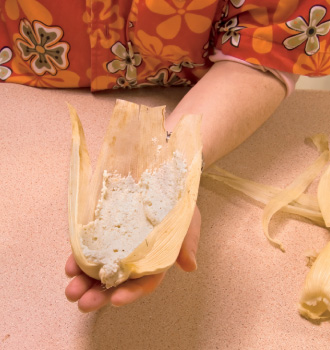
To assemble tamales in corn husks: Spread the masa in the center of the corn husk.
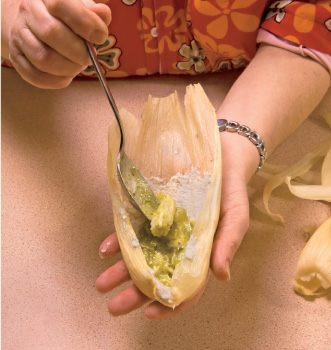
Place the filling in the center of the masa.
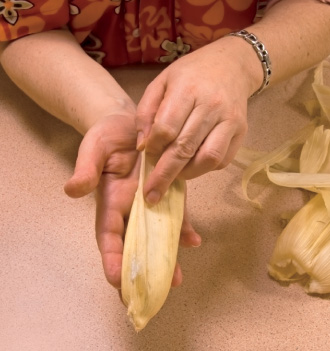
Fold the edges of the husk over the masa and filling.
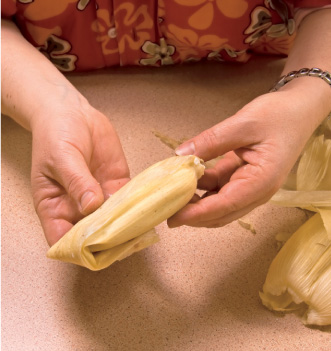
Fold down the top part of the husk.
Heat the oil in a medium saucepan over medium-high heat; when hot, add the blended sauce (careful, it will splatter) and stir. Reduce the heat to low; partially cover, and cook until slightly thickened, about 8 minutes. Add the shredded chicken and 1 teaspoon of the salt, or to taste, and cool; chill until ready to use.
In a large bowl, combine the masa harina and the remaining salt. Gradually, add the warm water, kneading until the dough reaches the consistency of thick mashed potatoes (or playdough); pour the lard into the masa and continue kneading until smooth. Cover the masa and let it rest for 10 minutes.
Working with one corn husk at a time, place it on a clean surface and wipe it dry. Using an offset spatula, spread 1/4 cup of masa onto the husk, shaping it into a roughly 3×3 1/2-inch rectangle, leaving a roughly 1 1/2-inch border on the long sides and a roughly 2-inch border on the short sides (the size of the husk will determine how much border you’ll have). Spread about 1 heaping tablespoon of the chicken over the masa; turn the tamale so it’s facing you lengthwise. Fold the long ends of the husk over the masa so that they meet in the middle. Bring the narrow tip of the husk over to the center of the tamal. Tie a husk strip around the center (where the tip meets the seam) of the tamal to secure it (but not too tight; it shouldn’t have a “waist”). When you’re done folding the tamal, the top end will not be sealed and you should be able to peek into the filling.
Fit a large Dutch oven with a steamer basket; stand the tamales (open side up) in the basket. Add 2–3 inches of boiling water to the pan; cover and bring to a boil over high heat. Lower the heat to a simmer and steam the tamales for 1 hour; remove from heat. Allow them to cool in the pot, covered, for 30 minutes.
Remove the husks and discard; serve tamales with crema and cheese.
NOTE: Once cooked and cooled, the tamales (still wrapped) can be refrigerated for up to 24 hours. To reheat, steam until hot, about 20 minutes. To store them longer, you’ll need to freeze them. To do so, cool them completely (still wrapped) and freeze in a single layer until solid. Transfer to zip-top bags and freeze for up to 3 months. To reheat, steam (without thawing beforehand) until hot, about 30–40 minutes.
Corn dumplings like these, with an earthy flavor and dressed with speckles of herbs, are commonly sold in Central American streets. As a little girl I’d watch in awe as the tamaleras (ladies who sell tamales) walked by balancing giant baskets filled to the rim on their heads without using their hands. Today, whenever I see this balancing act, I still wonder how they do it. This kind of tamal is often served in place of bread to sop up sauces from stews, such as pepianes (Guatemalan stews enriched with seeds and or nuts), or as an accoutrement to soups. Making tamales requires practice, but the experience can be tremendously rewarding. Children can easily get involved in making these. Once steamed, freeze the tamales for up to 3 months. To reheat, simply steam them until hot, and serve. Chipilín is a fragrant herb native to Central America and sold frozen or in jars in Latin American stores. If you can’t find it substitute cooked spinach or kale.
Makes about 2 1/2 dozen small tamales.
6 cups masa harina
2 teaspoons salt
5–5 1/2 cups warm water (or vegetable broth)
1 1/2 cups chilled lard or vegetable shortening
2 cups chipilín leaves, hard stems removed, pressed dry, and roughly chopped
1 cup grated queso seco or Cotija cheese
30 corn husks (plus more to cut into strips to tie the tamales), soaked in warm water as directed on pages 241–42
In a large bowl, combine the masa harina and salt. Gradually add the warm water, kneading with your hands, until the dough comes together into a ball and has the consistency of cookie dough. It should be smooth and not sticky.
Using an electric mixer, whip the lard at medium-high speed for 30 seconds to 1 minute or until fluffy. With the motor running at medium speed, add the dough by large pieces until all has been incorporated; continue beating until the dough has the consistency of thick mashed potatoes and is no longer sticky.
Transfer the masa to a large bowl. Add the chipilín and the cheese to the masa and knead it until all are combined. Cover the masa and let it rest for 10 minutes.
Working with one corn husk at a time, place it on a clean surface and wipe it dry. Using an offset spatula, spread roughly 1/3 cup of the masa in the center of the husk, shaping it into a roughly 3×1 1/2-inch rectangle. With the short sides of the tamal facing you, leave a 2-inch border at the bottom and a 1-inch border at the top. Following the natural bend of the husk, fold the sides over the masa and then fold the bottom part of the husk over. Tie loosely with a corn husk strip to hold it together. (The top of the tamal will be open).
Fit a large stockpot or Dutch oven with a steamer basket; stand the tamales (open side up) in the basket. Add 2–3 inches of boiling water to the pot; cover and bring to a boil over high heat. Lower the heat to a simmer and steam the tamales for 45 minutes. Allow them to cool for 20 minutes before serving; remove the husks and serve hot.
NOTE: Once cooked and cooled, the tamales (still wrapped) can be refrigerated for up to 24 hours. To reheat, steam until hot, about 20 minutes. To store them longer, you’ll need to freeze them. To do so, cool them completely (still wrapped) and freeze in a single layer until solid. Transfer to zip-top bags and freeze for up to 3 months. To reheat, steam (without thawing beforehand) until hot, about 30–40 minutes.
Corn and Cinnamon Tamales with Raisins and Cheese (Humintas or Tamalitos de Elote)
Sweet corn dough meets savory cheese, transforming dainty tamales into portable corn puddings. Sweet tamales speckled with fruit and sweet spices are found throughout Latin America. The real star here is the corn and not the masa, which is only used as a binding agent. Unlike other tamales, these are enclosed in fresh corn husks. The tender leaves furl up to hug the dumplings as they steam. For my eighteenth birthday—my last in Guatemala—my university classmates arrived at my parents’ home at dawn with a mariachi band and a whole lot of firecrackers that awoke our neighbors. My mother, who had been warned of the planned serenata, invited them all to a breakfast that included huevos rancheros, tamales like these, and hot chocolate (page 324).
Makes 24 small tamales
12–13 ears of corn (to yield 6 cups fresh corn kernels), husks reserved (see note)
1 cup lard or vegetable shortening (do not use butter)
1 1/4 cups sugar
1 1/2 cups grated queso seco or Cotija cheese (or Parmesan, in a pinch)
1 teaspoon ground cinnamon (see note)
Pinch salt
1 1/2 cups masa harina (a bit more or less depending on moisture content of the fresh corn)
1/2 cup raisins
Select 5 or 6 corn husks to cut into 24 strips (long enough to tie around each tamal); keep them submerged in cold water and set them aside.
With a sharp knife, cut the corn kernels from the ears of corn and place them in the bowl of a food processor fitted with a metal blade. Pulse for eight, five-second intervals or until the corn is mashed but still retains texture. (If you overprocess, you’ll have corn juice, so easy does it! The kernels must be finely chopped but some tiny pieces should be discernible for texture.)
With an electric mixer, cream the lard and sugar together until fluffy. Add the corn, cheese, cinnamon, and salt; blend at low speed until they are incorporated. Gradually add the masa until the dough holds together when pressed between your fingers. It’ll feel like thick mashed potatoes (if it’s too wet, add more masa harina). Stir in the raisins just until combined. Cover with plastic and let rest at room temperature for 20 minutes.
Drain the husks and dry them between paper towels—just enough to remove excess water. Place roughly 1/4 cup of the prepared dough in the center of a husk, shaping it into a long log with your fingers, leaving 1/3 of the corn husk free of dough at the bottom and at least 1 inch free at the top. Wrap the masa in the husk—the husk will embrace it as if it were still hugging the cob. Fold the bottom tip of the husk up to where the seams meet in the center of the tamal (the top part of the tamal will be open); tie it securely with a strip of corn husk (not too tight; it shouldn’t have a “waist” or it’ll explode while it cooks). Repeat with the remaining corn husks and dough.
Fit a large stock pot with a steamer basket. Stand the tamales (open side up) in the basket. Add 2-3 inches of boiling water to the pot; cover, and bring the water to a boil over medium-high heat; reduce the heat to a simmer and steam the tamales for 1 hour, replenishing the water, as needed. Remove the pot from the heat and allow the tamales to rest, covered, for 30 minutes. Serve warm.
NOTE: To remove the husks from the fresh corn, slice off the bottom of the corn stalks. Unfurl them one at a time—being careful not to rip them. Soak the husks in cold water for at least 1 hour (up to 3 hours).
For a more authentic flavor, use Mexican cinnamon sticks (canela). To grind, use a coffee grinder or a mortar and pestle.
These tamales are best eaten fresh but can be frozen after they’re cooked (still wrapped) for up to 3 months. Steam them again until they are hot, about 20–25 minutes.
